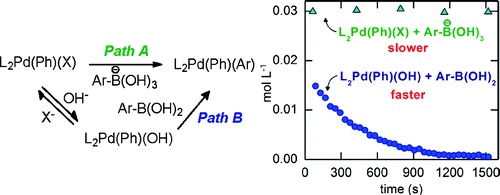Distinguishing Between Pathways for Transmetalation in Suzuki-Miyaura Reactions
J. Am. Chem. Soc, 2011, 133 (2116-2119)
View on publisher site
Abstract
We report a systematic study of the stoichiometric reactions of isolated arylpalladium hydroxo and halide complexes with arylboronic acids and aryltrihydroxyborates to evaluate the relative rates of the two reaction pathways commonly proposed to account for transmetalation in the Suzuki−Miyaura reaction. On the basis of the relative populations of the palladium and organoboron species generated under conditions common for the catalytic process and the observed rate constants for the stoichiometric reactions between the two classes of reaction components, we conclude that the reaction of a palladium hydroxo complex with boronic acid, not the reaction of a palladium halide complex with trihydroxyborate, accounts for transmetalation in catalytic Suzuki−Miyaura reactions conducted with weak base and aqueous solvent mixtures.
Read on publisher's site